Dog Licking Paws Remedies: Causes and Treatments
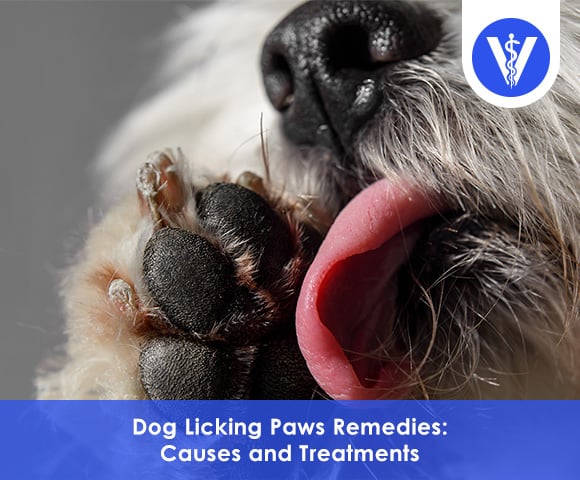
Table of Contents
Dog-licking paws remedies are necessary when a dog licks at the paws repetitively and excessively. Paw licking is normal when incorporated into the dog’s grooming routine but disruptive and destructive when overindulged.
Dogs lick their paws excessively due to physical injuries, conditions affecting the paws, or behavioral problems. Constant licking is irritating and worsens the paw issue.
Pet owners ask how to stop a dog licking paws with home remedies and how to stop dog licking paws in general. Dog-licking paw remedies range from simple natural soaks and supplements to antibiotic courses and surgery, depending on the underlying cause.
Contact the veterinarian if the paw-licking scenario is excessive, prolonged, or accompanied by additional abnormal symptoms. The veterinarian is able to recommend a management strategy, and at-home dog-licking paw remedies are soothing until the treatment takes effect.
Why do Dogs Lick their Paws?
Dogs lick their paws to stay clean, and paw licking is normal behavior in dogs. Excessive paw licking is a sign of anxiety, boredom, or behavior issues. The repetitive motion of licking soothes an emotionally unwell dog. Dogs lick their paws for other reasons, such as skin irritations, footpad injuries, growths, pain, allergies, and parasites. Dogs lick the painful or uncomfortable area to remove the source of pain or discomfort.
Excessive paw licking has harmful effects on the skin, causing additional irritation and secondary infections, and warrants prompt attention. At-home dog-licking paws remedies work in milder situations, but more severe cases, like dog depression, require veterinary help.
Is Dogs Licking Paws Not Normal?
No, dogs licking paws excessively is not normal. Donnelly T. published a study, “A Firm, Pea-Shaped Lesion on the Paw of a Beagle,” 2007, stating that “licking a paw is not normal in dogs, as it can be a sign of discomfort or pain.” Dogs licking paws excessively benefit from a range of natural and medical dog licking paws remedies.
Occasional and moderate paw licking is expected. Dogs lick certain body parts, including the tail, legs, and paws, when self-grooming to remove dirt and debris.
Self-bathing and grooming are standard behaviors in dogs and indicate the dog is healthy and wants to be clean. A dog licking paws to remove dirt is common after spending time outside.
How Do I Know if My Dog Is Licking His Paws Excessively?
You know your dog is licking his paws excessively if the paws are stained, have sores, or a smelly discharge. The paw licking is overindulgent when it becomes disruptive or even destructive.
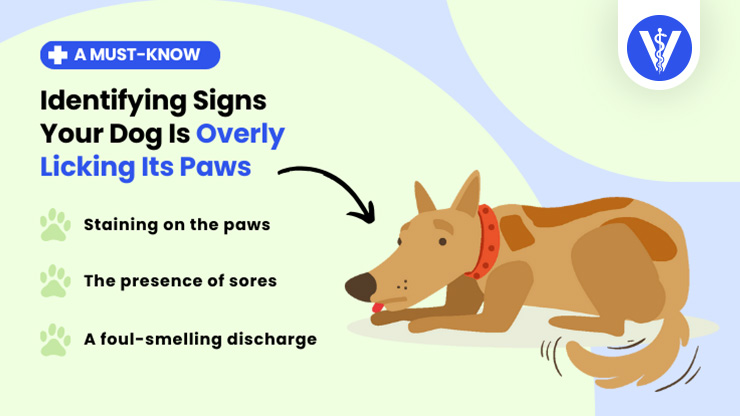
The behavior is excessive if the dog stops eating, pauses while playing, or wakes up to lick its paws. The paw licking is overindulgent if there is staining on the dog’s paws, accompanied by other signs like sores, open wounds, and smelly discharge.
Interference with daily activities and physical changes on the paws indicate the dog is licking its paws excessively and requires dog-licking paw remedies.
Does Dog Always Licking its Paws Indicate Problems?
No, licking paws does not always indicate problems. Moderate licking is normal as part of a dog’s grooming routine.
Excessive licking that disrupts the dog’s daily habits is a sign the dog needs dog-licking paws remedies and investigation into an underlying problem.
What are the Symptoms of Dog Licking Paws mean?
The symptoms of dog licking paws are listed below.
- Staining: Fur staining is the effect of constant saliva exposure and is more easily visible in dogs with lighter coat colors. For example, a white dog has striking rust-colored stains after excessive paw licking.
- Hair Loss: Constant irritation and moisture damage the hair follicle, resulting in bald patches. The hair loss is most pronounced on the affected area of the dog’s paws and is partial or complete.
- Discharge: The processes occurring in the dog’s paws and triggering licking result in the production of discharge in some cases. The discharge varies in color and scent, but it is a sign of excessive licking, requiring dog licking paws remedies.
- Foul Smell: A foul odor is a common symptom of overindulgent dog paw licking. The excessive licking and bad smell indicate infection.
- Lesions: Excess dog paw licking manifests with the formation of new lesions affecting the superficial or, in more severe cases, deep skin layers, triggering ulcers and open wounds.
What are the Causes of Dogs Licking Paws Excessively?
The causes of dogs licking paws excessively are listed below.
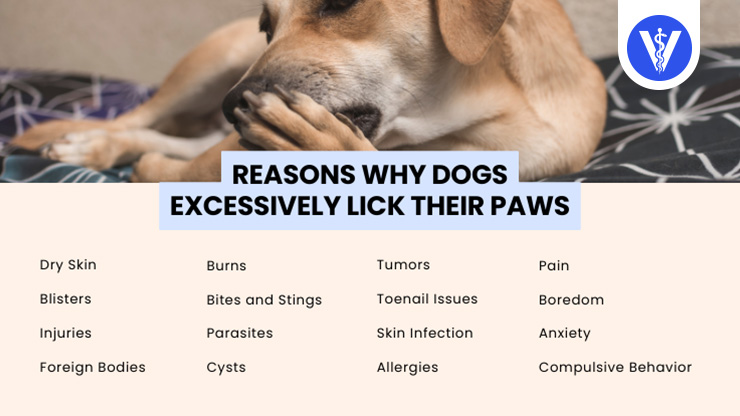
- Dry Skin: Dry skin in dogs manifests as cracked skin, excess flaking, or dandruff. Dry skin, depending on the severity, is uncomfortable or painful. Paw licking is an attempt to soothe the pain. Dog licking paws remedies support dry skin.
- Blisters: Blisters are small bubbles filled with clear liquid forming under the top layer of the skin. Blisters develop in places prone to continuous friction, like between the toes, and are painful. Dogs with toe blisters lick their paws.
- Injuries: Physical injuries are common on the dog’s paw pads and result in licking due to pain. Cuts are the most frequently seen injury caused by stepping on shards of broken glass or sharp objects.
- Foreign Bodies: Dogs licking paws are frequently caused by foreign bodies embedded into the dog’s pads and between the toes. Fox tails, grass awns, thorns, and pebbles are widespread causes.
- Burns: Paw burns in dogs are caused by physical or chemical factors. Physical burns occur when walking on hot pavement, and chemical burns when stepping on surfaces cleaned with strong chemicals or, during winter, on salt and de-icing agents.
- Bites and Stings: Insect bites and stings occur frequently in dogs and are usually located on the dog’s muzzle or paws. Bites and stings are painful and create a burning sensation, which dogs are tempted to relieve by licking the affected area.
- Parasites: Tick and mite infestations make dogs itchy and manifest with paw licking. Ticks burrow between the dog’s toes and pads. Scabies mites live on the skin’s surface, and Demodex mites deep into the hair follicles.
- Cysts: Defined as fluid-filled swellings, cysts often form on the paws, more specifically between the toes, and result in the nuisance dog licking paws behavior. Cysts stem from embedded foreign material.
- Tumors: The dog’s paws are prone to developing malignant squamous cell carcinomas (SCC) and two benign tumors, plasmocytomas and histiocytomas. Plasmocytomas are more common in senior dogs, while histiocytomas form in puppies and young adult dogs.
- Toenail Issues: Problems with the toenails result in the dog licking its paws excessively. The top two toenail-related issues in dogs are ingrown and torn nails. Ingrown nails result from irregular nail clipping, and torn nails are caused by physical injuries.
- Skin Infection: Infections occur when the skin’s protective layer is damaged and are caused by bacteria or yeast. Skin infections and paw licking fuel each other as irritation triggers licking, adding moisture and creating the perfect environment for germs. Dog-licking paw remedies help reduce skin infections in dogs.
- Allergies: Allergies are widespread in dogs and manifest with itching and licking paws. Allergies in dogs are caused by environmental factors (like pollen, dust, or smoke), food ingredients, flea saliva, and allergens in contact with the dog’s skin.
- Pain: Pain is a common cause of a dog licking paws. Licking is soothing, and dogs force the habit to relieve the pain. The pain stems locally or is referred from an out-of-reach location and is usually associated with canine osteoarthritis, sprains, and strains. Dog-licking paws remedies help manage pain.
- Boredom: Lack of physical and mental stimulation makes dogs bored and destructive. Paw licking is a self-destructive habit of bored dogs. Boredom impacts the dog’s physical and mental well-being.
- Anxiety: Stress and anxiety are common in modern dogs and frequent triggers for paw licking. Repetitive motions are soothing for dogs. Anxious dogs cope with stress by indulging in repetitive activities like paw licking.
- Compulsive Behavior: Canine-compulsive disorder (CCD) is the dog equivalent of OCD in people. Compulsive behavior manifests with repetitive activities such as paw licking, tail chasing, and blanket sucking. Dog-licking paw remedies help manage compulsive behavior.
What are the Treatments for Dogs Excessively Licking Their Paws?
The treatments for dogs excessively licking their paws are listed below.
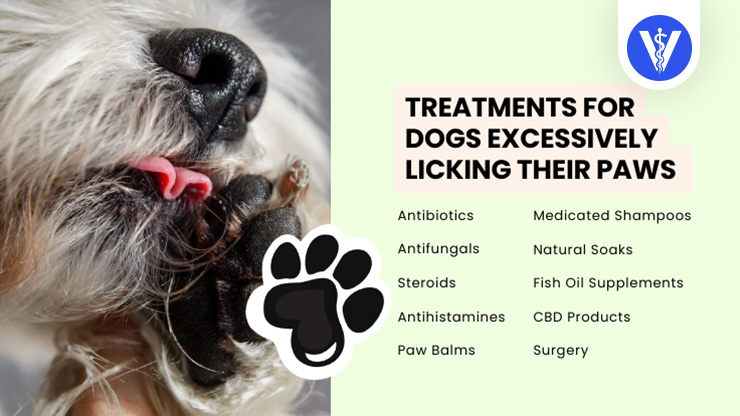
- Antibiotics: Oral and topical antibiotics are used to kill bacteria causing or worsening the paw inflammation. Dog licking paws remedies include antibiotics, which are always prescribed by a licensed veterinarian and must be used under the veterinarian’s guidelines.
- Antifungals: The veterinarian prescribes an antifungal instead of an antibiotic if the infection is associated with yeasts. Antifungals for dogs are used either orally or topically, depending on the situation.
- Steroids: Steroids are recommended in severe cases to help reduce inflammation and speed up healing. Long-term and irresponsible use of steroids in dogs is dangerous, and it is essential to follow veterinary instructions.
- Antihistamines: Antihistamines control allergic reactions and are used for dogs licking paws due to allergens. Antihistamines help relieve itchiness, which helps control licking. Antihistamines are used when managing insect stings and bites, too.
- Paw Balms: Dog licking paws remedies, including balms and waxes, help treat the licking issue by supporting paw health and wellness. There are moisturizing and nourishing products, depending on the formula.
- Medicated Shampoos: Medicated shampoos contain ingredients that help manage the source of the dog licking paws behavior. Dog shampoos are pH-balanced and feature soothing formulas to keep the paws clean and nourished.
- Natural Soaks: Natural soaks are among the most popular at-home dog licking paws remedies. The ingredients needed to make the soaks, like apple cider vinegar, oatmeal, and baking soda, are readily available, and the soaks are effective in soothing the paws.
- Fish Oil Supplements: Fish oil is rich in essential omega fatty acids which support skin health and wellness. Omega-3 fatty acids moisturize and nourish the skin while reducing skin irritation, inflammation, and itchiness.
- CBD Products: Topical CBD balms relieve itchiness and inflammation, while oral CBD oils and treats support general skin health and promote moisturization. The pet market offers a variety of dog CBD products, making them a readily available remedy.
- Surgery: Surgery is recommended for severe cases when the dog licking paws scenario is caused by embedded foreign objects, deep cuts in need of stitches, and tumors that must be removed.
Can Treatments for Dogs’ Excessive Paw Licking be Made at Home?
Yes, treatments for dogs’ excessive paw licking can be made at home. Natural at-home dog licking paws remedies are easy to prepare, safe, and effective. Popular options include white or apple cider vinegar, baking soda, and oatmeal soaks.
A white or apple cider vinegar soak is made by mixing three tap water parts with one vinegar. Soak the dog’s paw in the solution for 10 minutes and then rinse profusely. White and apple cider vinegar must not be used on injured paws, so check for cuts before treatment.
A baking soda soak for dogs licking paws excessively is made by putting half a cup of baking soda into a bucket of warm water. Soak the paw for at least 10 minutes, rinse with copious amounts of water, and repeat the treatment two to three times per day.
Oatmeal is among the most popular dog licking paws remedies. Grind oatmeal into a fine powder. Add two cups of the oatmeal powder into a bucket of warm water. Soak the dog’s paws for 10 minutes, rinse, and repeat if necessary.
Can CBD Help Treat Dogs’ Excessive Paw Licking?
Yes, CBD can help treat dogs’ excessive paw licking. CBD, or cannabidiol, is a naturally occurring compound found in the Cannabis sativa plant. CBD is health-boosting and safe for dogs over the age of four months.
CBD works through the endocannabinoid system (ECS). Cannabinoids replace the body’s natural cannabinoids and interact with the CB1 and CB2 receptors. Dogs have a relatively thin skin rich in cannabinoid receptors.
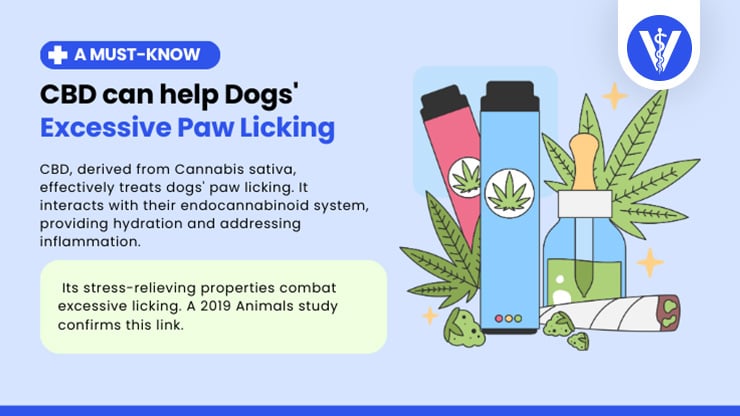
The CBD treatment for dogs licking paws excessively works on several levels. CBD is rich in fat molecules that are hydrating and nourishing, promoting skin health. CBD helps with paw issues through its potent anti-inflammatory, antimicrobial, and antioxidant properties.
Cannabinoids work as dog licking paws remedies. CBD helps relieve stress and anxiety, which are common causes of excess paw licking in dogs and exacerbate the behavior.
Animals published a study, “Behavioural Differences in Dogs with Atopic Dermatitis Suggest Stress Could Be a Significant Problem Associated with Chronic Pruritus,” in 2019, showing a link between stress and itchiness directly associated with licking.
Why you should have Quality Time for your Dogs?
You should have quality time for your dogs because owners and dogs benefit from the relationship. Dogs contribute to their owners’ health and happiness, boosting their social lives. A dog licking paws excessively benefits from quality time because it reduces boredom and helps owners notice symptoms quickly.
For example, spending quality time together enriches the dog’s life, and playing games provides mental and physical stimulation. A mentally and physically challenged dog is unlikely to get bored, a common cause of paw licking.
Owners spending time with dogs means the owner is familiar with the dog’s body language, which makes it easier to see if something is wrong. Where dog licking is noticeable and unusual, the owner is able to notice and seek prompt diagnosis and dog licking paws remedies and treatment.
What are the Long-Term Effects of Dogs Always Licking Their Paws?
The long-term effects of dogs always licking their paws are listed below.
- Pododermatitis: Pododermatitis is an infection of dog paw skin and affects the interdigital spaces, footpads, nail folds, and nails. A study, “Canine Pododermatitis,” published in 2016 in the Canadian Veterinary Journal, says that pododermatitis is “complex, multifactorial, and may be frustrating to diagnose and treat.” Pododermatitis is known by many names, including pedal folliculitis and furunculosis, and is associated with prolonged or excessive paw licking. Dog licking paw remedies are able to help.
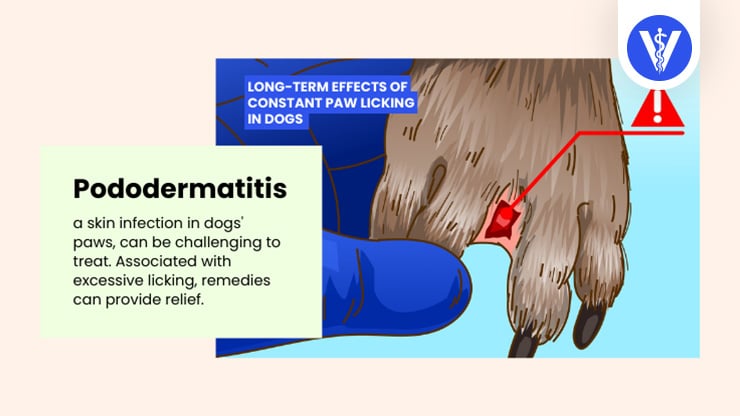
- Canine Pyotraumatic Dermatitis (Hot Spots): Canine pyotraumatic dermatitis is a localized, fast-developing, superficial, exudative, and moist inflammation affecting the superficial layers of skin. Hot spots develop due to self-inflicted trauma or excessive licking of the paws. Palmer L. issued a case study, “Picture This: Management of Canine Pyotraumatic Dermatitis (a.k.a., Hot Spot)” in 2018, explaining that hot spots are “extremely pruritic and distracting and significantly interfere with the canine’s operational effectiveness and ability to stay on task.”
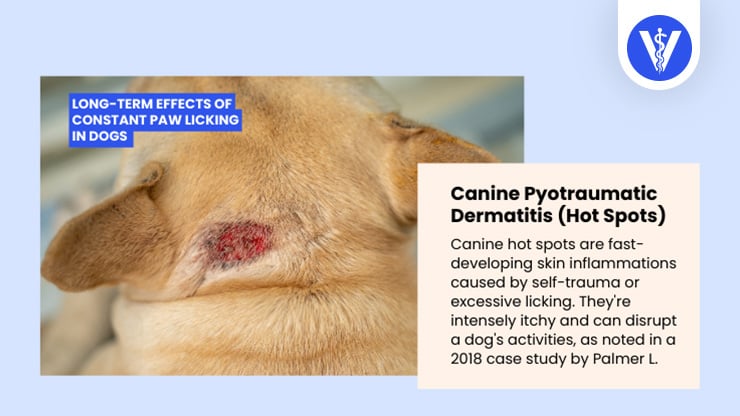
- Secondary Infections: Excessive paw licking dampens the area and adds moisture, creating the perfect environment for bacteria and yeast growth. Secondary bacterial and yeast infections of the paws worsen the symptoms and add to the problem. Veterinary Dermatology issued an observational study, “Association between skin surface pH, temperature and Staphylococcus pseudintermedius in dogs with immunomodulatory responsive lymphocytic-plasmacytic pododermatitis,” stating that “secondary bacterial infection is a frequent complication in lesional skin of dogs.”
- Acral Lick Dermatitis: Acral lick dermatitis, a.k.a. lick granuloma, is a sore, red skin patch caused by the dog continuously and obsessively licking the area. VCA Hospitals states lick granuloma is characterized by a “cycle of self-trauma, inflammation, and infection.” Patel A., in her 2010 paper “Acral Lick Dermatitis,” explains that dogs with underlying skin issues “develop an itch/lick cycle that may result in the production and release of endorphins, leading to euphoria and obsessive-compulsive behavior.” Dog licking paw remedies are able to help.
When should you Go to the Veterinarian?
You should go to the veterinarian for dog licking paws if the behavior is sudden, excessive, persisting, or accompanied by additional worrisome signs. Uncontrolled licking damages the paws and annoys the dog and the owner.
At-home dog licking paws remedies are available and simple. Consult a veterinarian to determine the underlying cause before self-treating. The veterinarian prescribes medications and dog licking paw remedies to speed up healing.
Can Paw Licking for Dogs be Treated?
Yes, paw licking for dogs can be treated. The veterinarian diagnoses the underlying cause and suggests treatment. A multimodal approach, including prescription drugs and at-home dog licking paws remedies, works best.
Successful treatment usually takes time because the dog’s paws are under constant pressure, prolonging healing.
Pet owners must maintain paw health and prevent future problems once the paw licking is treated.
Proper paw care includes daily inspections (especially after going outside), cleaning the paws (washing or using dog wipes), regular use of moisturizers (regular and CBD paw balms formulated for canines), and investing in protective boots for safe winter walks.
Can Dogs Have Anxiety?
Yes, dogs can have anxiety. Anxiety is defined as fear of impending threat or danger and affects more than 70% of the modern canine population. Long-term anxiety reduces the dog’s quality of life and increases the risk of specific ailments, like inflammatory bowel disease and allergies.
Dog anxiety is triggered by genetics, separation, social events, past trauma, loud noises, old age, and pain. An anxious dog is prone to excessive vocalization, drooling, shivering, destructiveness, and repetitive behaviors like paw licking.
Managing anxiety in dogs requires a multimodal strategy, including behavior modification (counterconditioning and desensitization), anti-anxiety medications, dog licking paws remedies, relaxing aids (music, PEMF therapy, massages), and natural calming supplements like pet CBD products.
















